Novel Nonlinear High Order Technologies for Damage Diagnosis of Complex Assets
Abstract
:1. Introduction
- technology validations via extensive experiments
- comparison of the proposed technology and the cross-covariance technology, based on t complex spectra
- propose new damage diagnosis technologies, cross-correlations of moduli for steady and non-steady functioning of complex systems,
- perform technology testing via extensive experiments using motor current signal processing and,
- perform technology comparisons between triple cross-covariance technologies, based on complex spectra, using motor current signature analysis.
2. The Cross-Correlations of Spectral Moduli
- a difficulty of a visual representation of the CCSM for orders greater than 4
- a computation complexity
- technologies are becoming non-effective at an excessive level of interference
- segmentation of current data into K non-overlapped segments of N samples each
- estimation of DFT coefficients for each segment
- calculation of CCSM3 estimates for all segments via multiplications of moduli of the selected DFT coefficients, and average these estimates over K segments
3. Experimental Setup and Technology Validation
3.1. Setup for Experimental Technology Validation
- two inner race damaged bearings vs. two undamaged bearings
- two outer race damaged bearings vs. two undamaged bearings
3.2. Local Inner Race Damage Diagnosis
3.3. Outer Race Local Damage Diagnosis
- coefficients (Equation (10)) for the three characteristic spectral components are used for CCSM3 technology as in [1]: i.e., 1,1; 2,1, and 1, −1
- processing parameters: i.e., 65.536 kHz sampling frequency, 5 s time segment, signal duration is 65 s, overlap, varying from 0 to 50%, with a 1% step, are used for CCSM3 technology as in [1]
- normalization of unnormalized correlations/covariances
- number of diagnostic features for damaged and undamaged bearings are used for CCSM3 technology as in [1]
- the Bayes decision-making method is used for CCSM3 technology as in [1].
4. Conclusions
Author Contributions
Funding
Acknowledgments
Conflicts of Interest
Appendix A
| Correlation Number | i | j | k |
|---|---|---|---|
| 1 | 3 | −3 | −3 |
| 6 | −3 | −3 | |
| 9 | −3 | −3 | |
| 2 | 3 | −1 | −3 |
| 6 | −1 | −3 | |
| 9 | −1 | −3 | |
| 3 | 3 | 1 | −3 |
| 6 | 1 | −3 | |
| 9 | 1 | −3 | |
| 4 | 3 | 3 | −3 |
| 6 | 3 | −3 | |
| 9 | 3 | −3 | |
| 5 | 3 | −3 | −2 |
| 6 | −3 | −2 | |
| 9 | −3 | −2 | |
| 6 | 3 | −1 | −2 |
| 6 | −1 | −2 | |
| 9 | −1 | −2 | |
| 7 | 3 | 1 | −2 |
| 6 | 1 | −2 | |
| 9 | 1 | −2 | |
| 8 | 3 | 3 | −2 |
| 6 | 3 | −2 | |
| 9 | 3 | −2 | |
| 9 | 3 | −3 | −1 |
| 6 | −3 | −1 | |
| 9 | −3 | −1 | |
| 10 | 3 | −1 | −1 |
| 6 | −1 | −1 | |
| 9 | −1 | −1 | |
| 11 | 3 | 1 | −1 |
| 6 | 1 | −1 | |
| 9 | 1 | −1 | |
| 12 | 3 | 3 | −1 |
| 6 | 3 | −1 | |
| 9 | 3 | −1 | |
| 13 | 3 | −3 | 0 |
| 6 | −3 | 0 | |
| 9 | −3 | 0 | |
| 14 | 3 | −1 | 0 |
| 6 | −1 | 0 | |
| 9 | −1 | 0 | |
| 15 | 3 | 1 | 0 |
| 6 | 1 | 0 | |
| 9 | 1 | 0 | |
| 16 | 3 | 3 | 0 |
| 6 | 3 | 0 | |
| 9 | 3 | 0 | |
| 17 | 3 | −3 | 1 |
| 6 | −3 | 1 | |
| 9 | −3 | 1 | |
| 18 | 3 | −1 | 1 |
| 6 | −1 | 1 | |
| 9 | −1 | 1 | |
| 19 | 3 | 1 | 1 |
| 6 | 1 | 1 | |
| 9 | 1 | 1 | |
| 20 | 3 | 3 | 1 |
| 6 | 3 | 1 | |
| 9 | 3 | 1 | |
| 21 | 3 | −3 | 2 |
| 6 | −3 | 2 | |
| 9 | −3 | 2 | |
| 22 | 3 | −1 | 2 |
| 6 | −1 | 2 | |
| 9 | −1 | 2 | |
| 23 | 3 | 1 | 2 |
| 6 | 1 | 2 | |
| 9 | 1 | 2 | |
| 24 | 3 | 3 | 2 |
| 6 | 3 | 2 | |
| 9 | 3 | 2 | |
| 25 | 3 | −3 | 3 |
| 6 | −3 | 3 | |
| 9 | −3 | 3 | |
| 26 | 3 | −1 | 3 |
| 6 | −1 | 3 | |
| 9 | −1 | 3 | |
| 27 | 3 | 1 | 3 |
| 6 | 1 | 3 | |
| 9 | 1 | 3 | |
| 28 | 3 | 3 | 3 |
| 6 | 3 | 3 | |
| 9 | 3 | 3 |





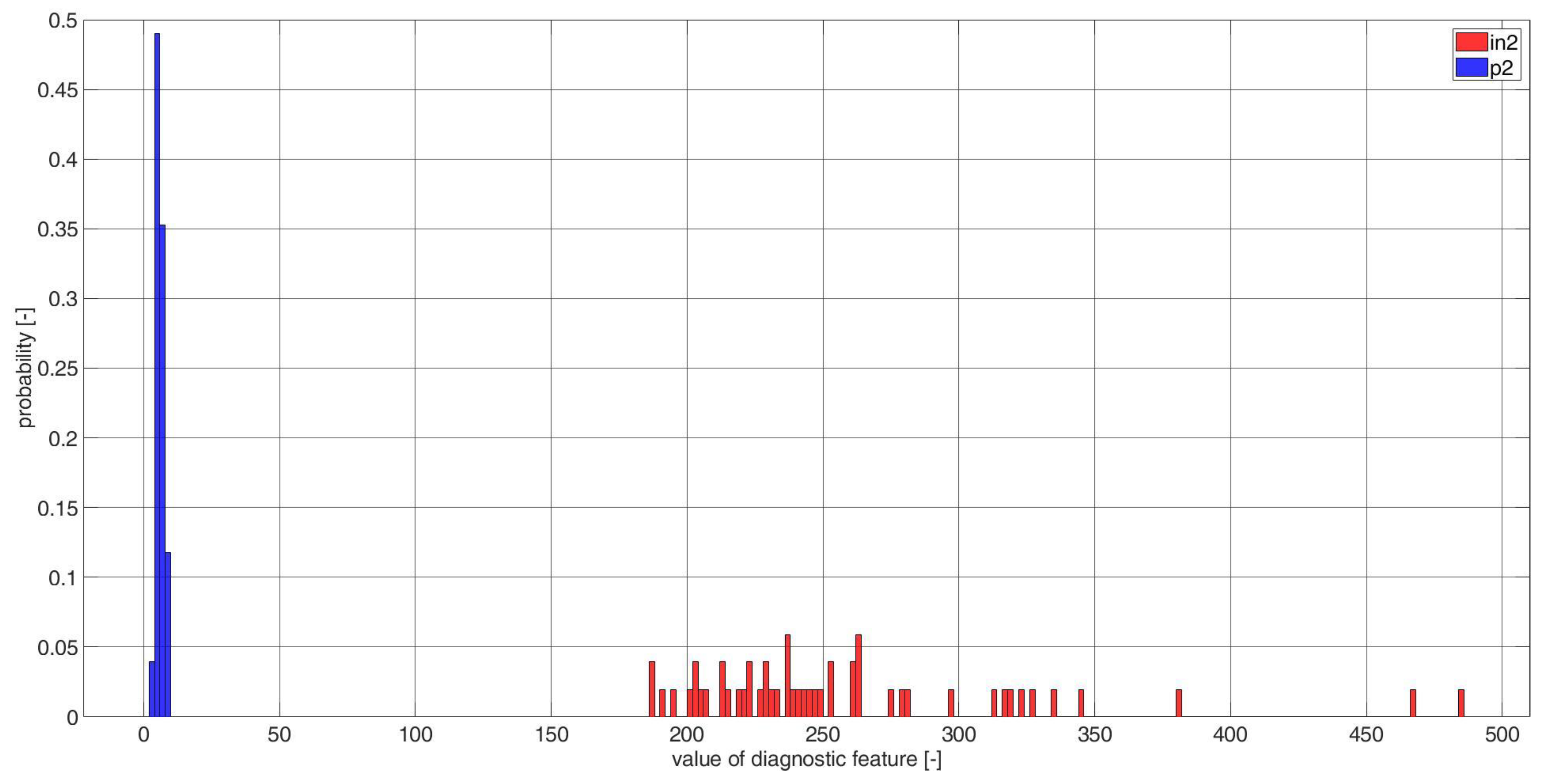
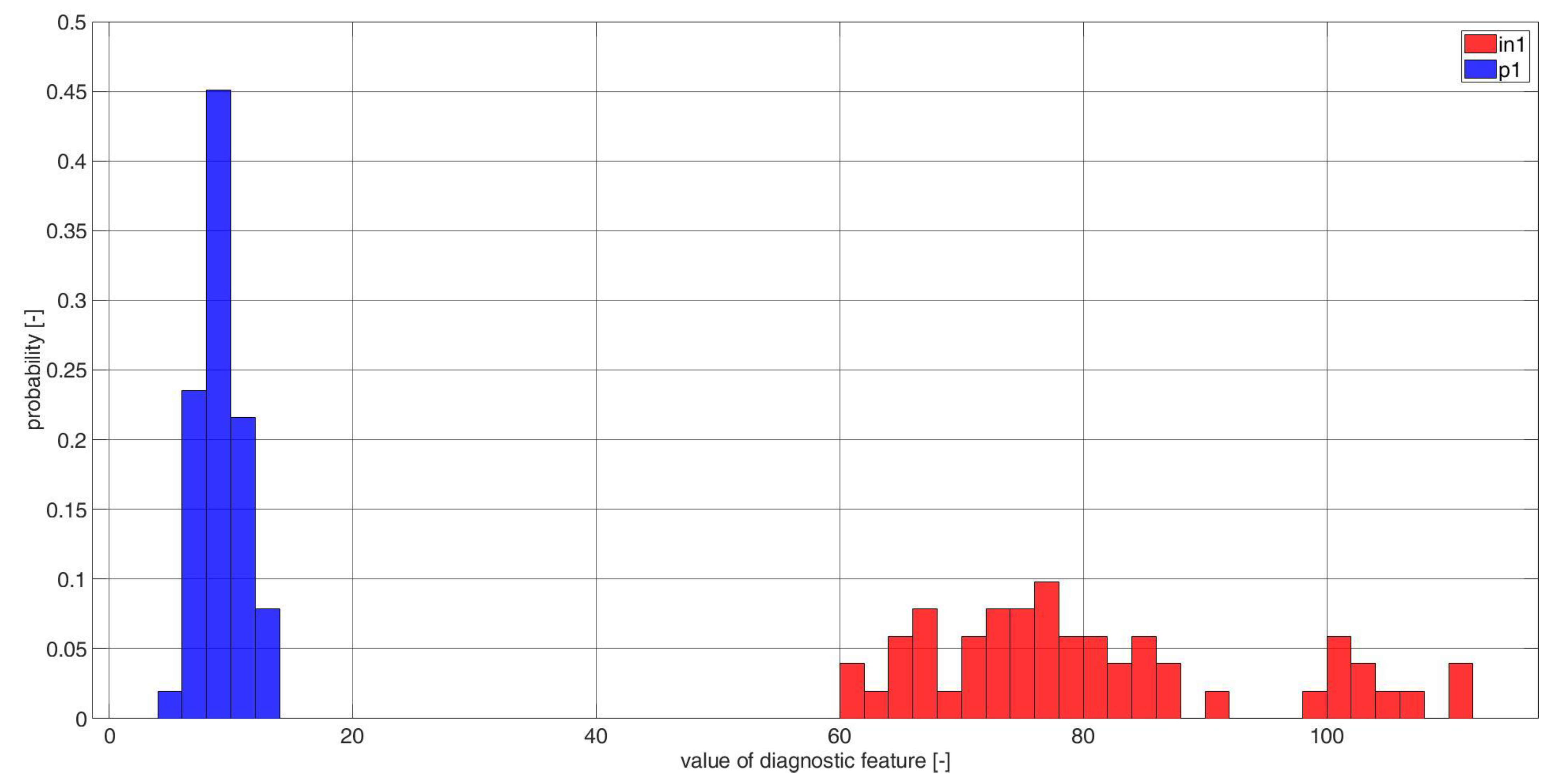



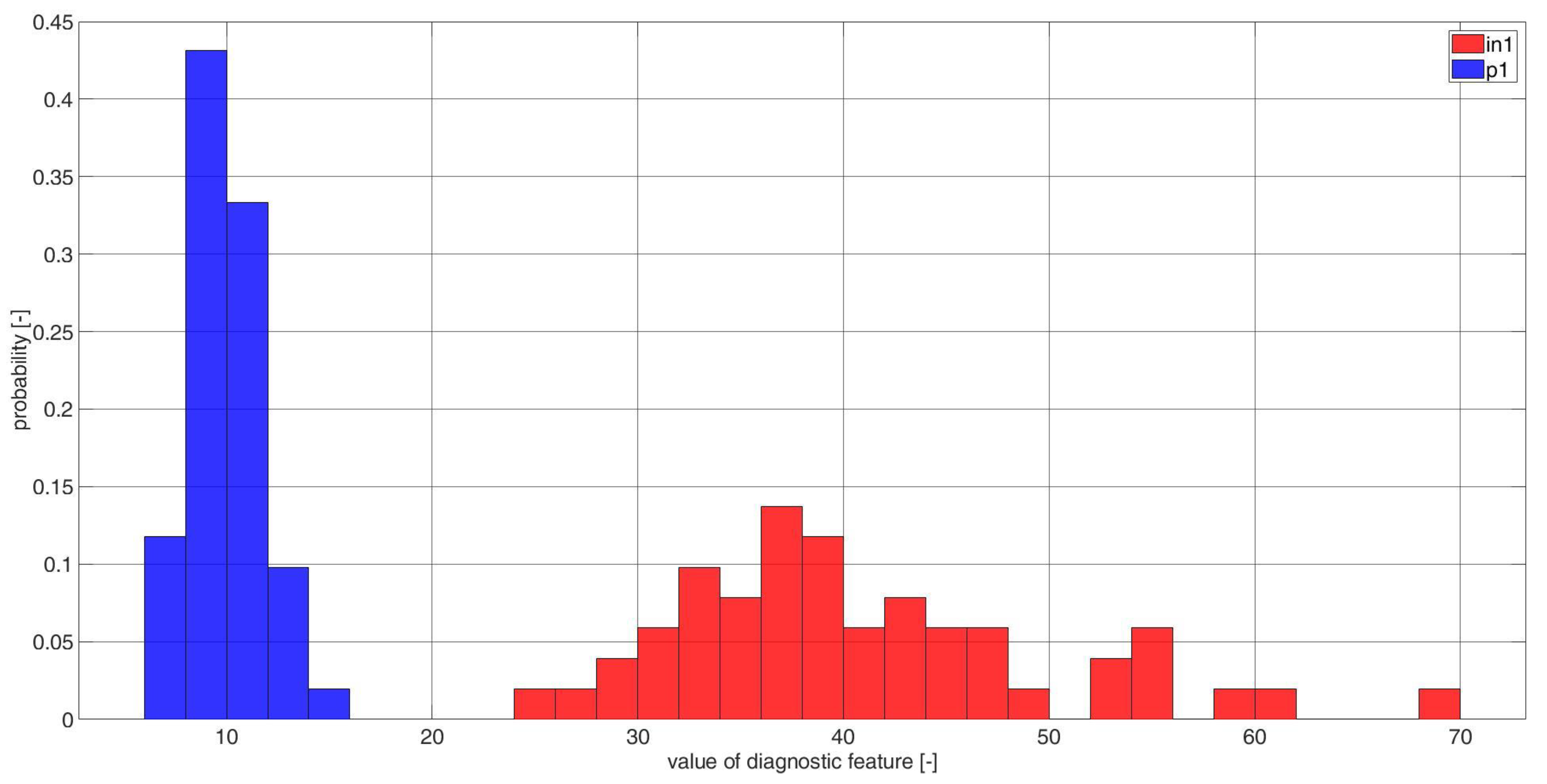
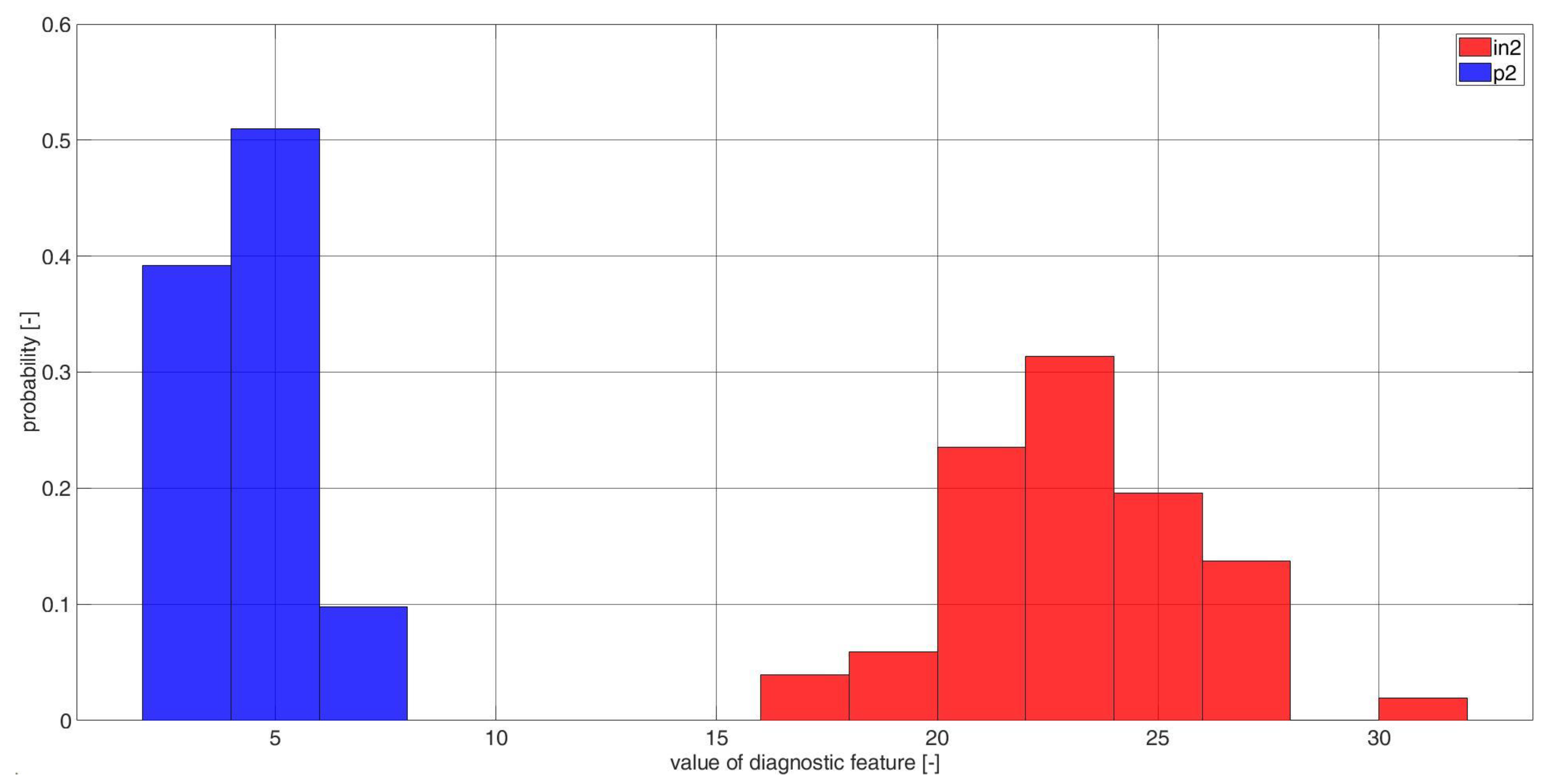


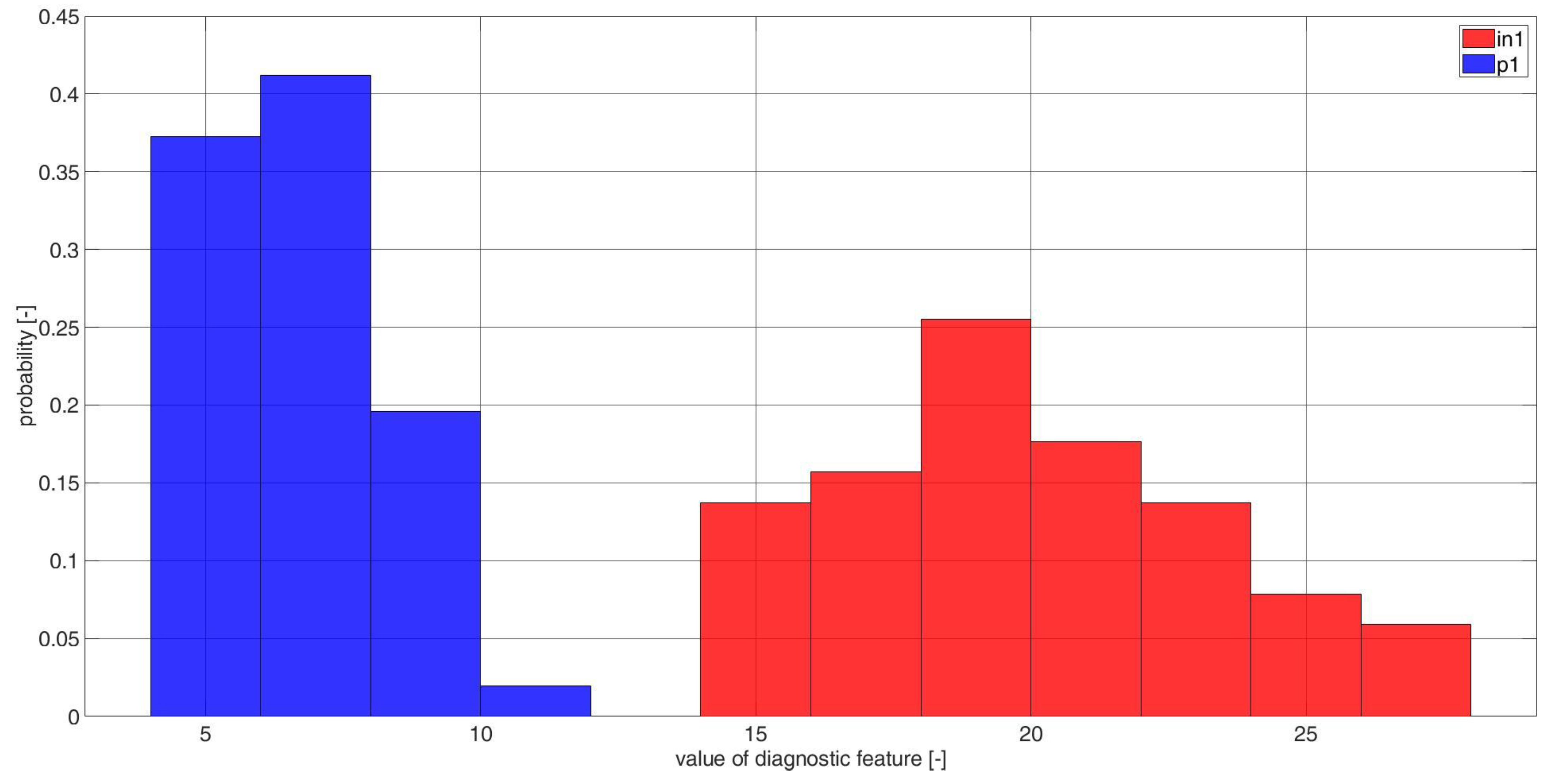
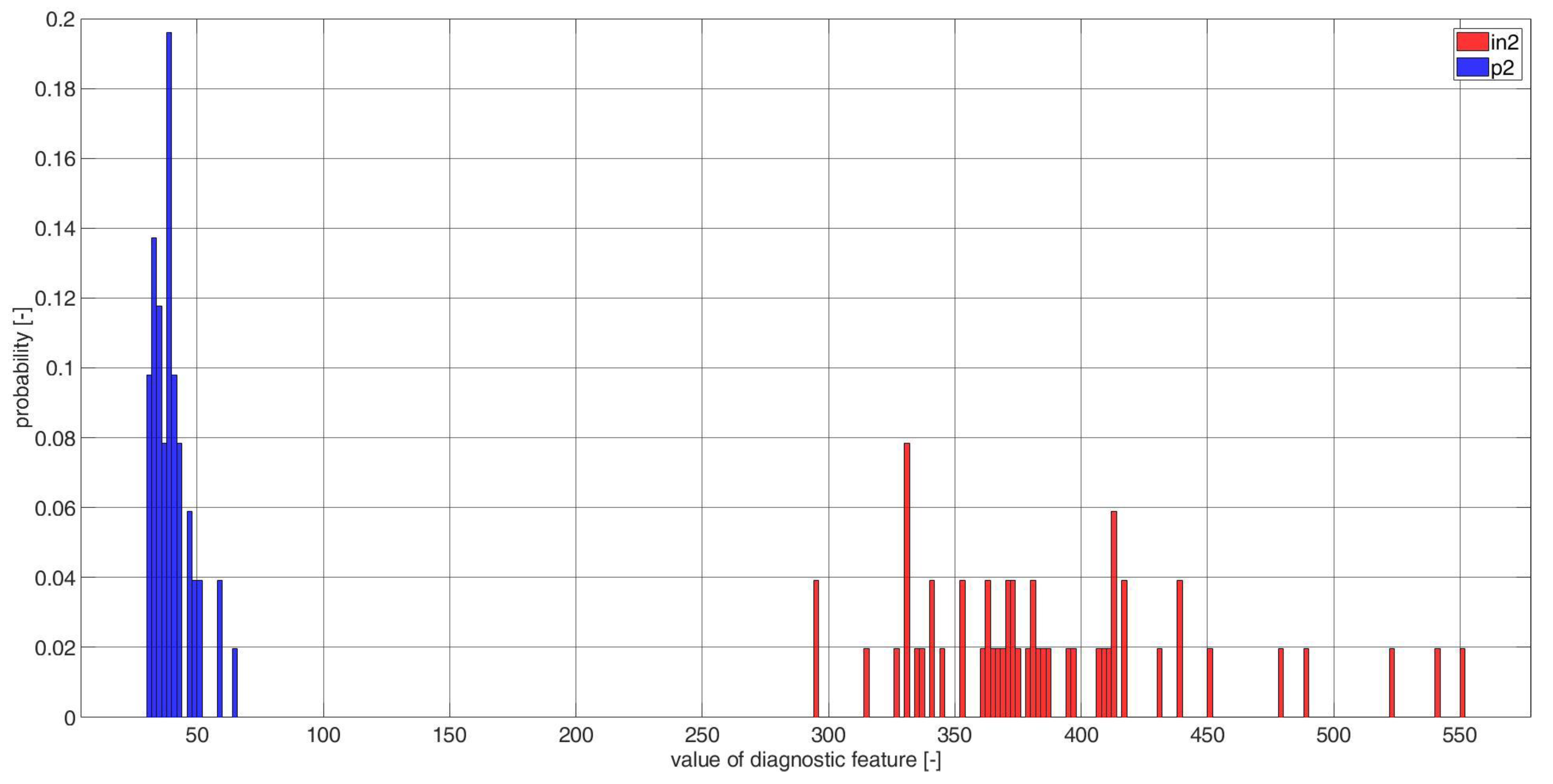
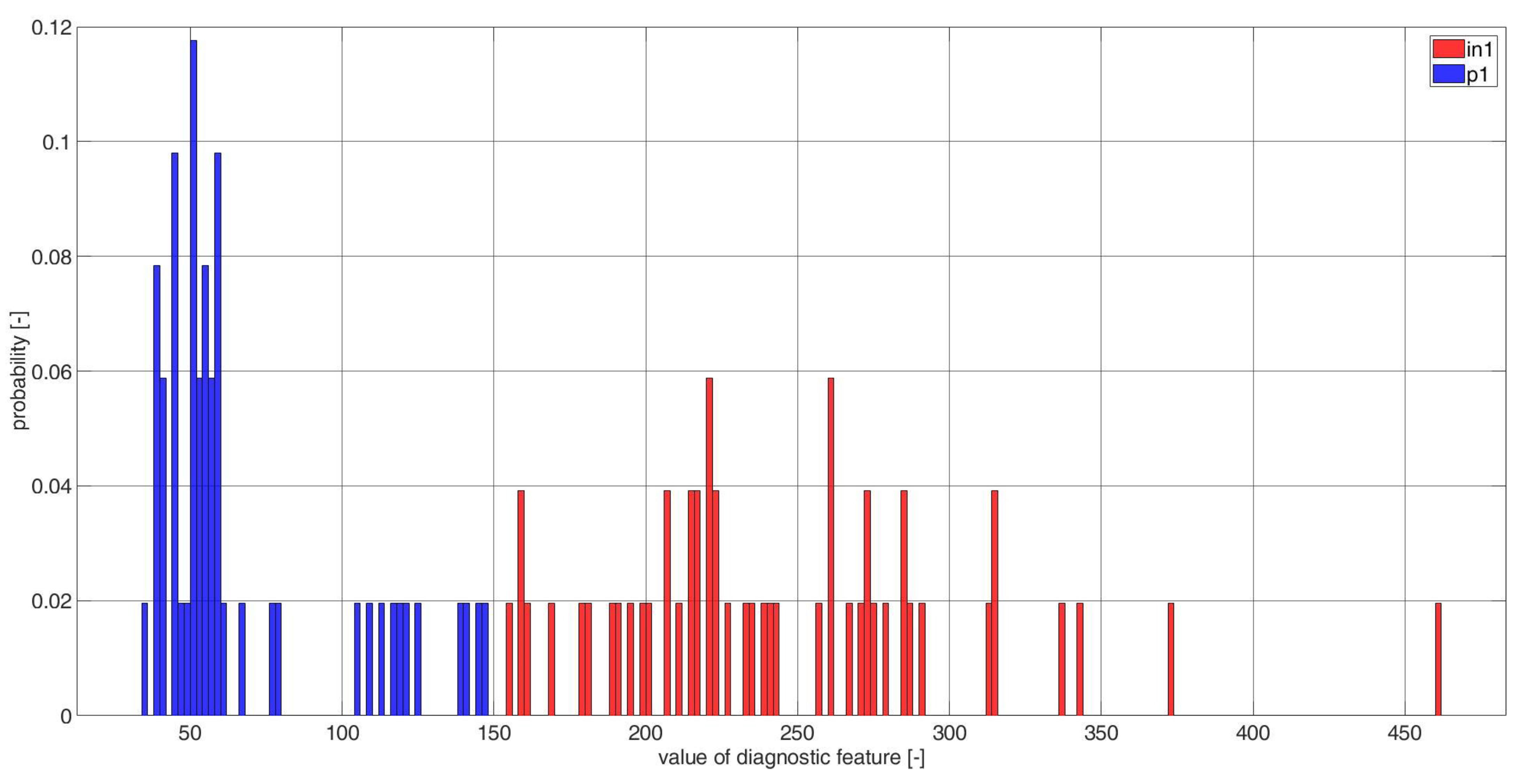
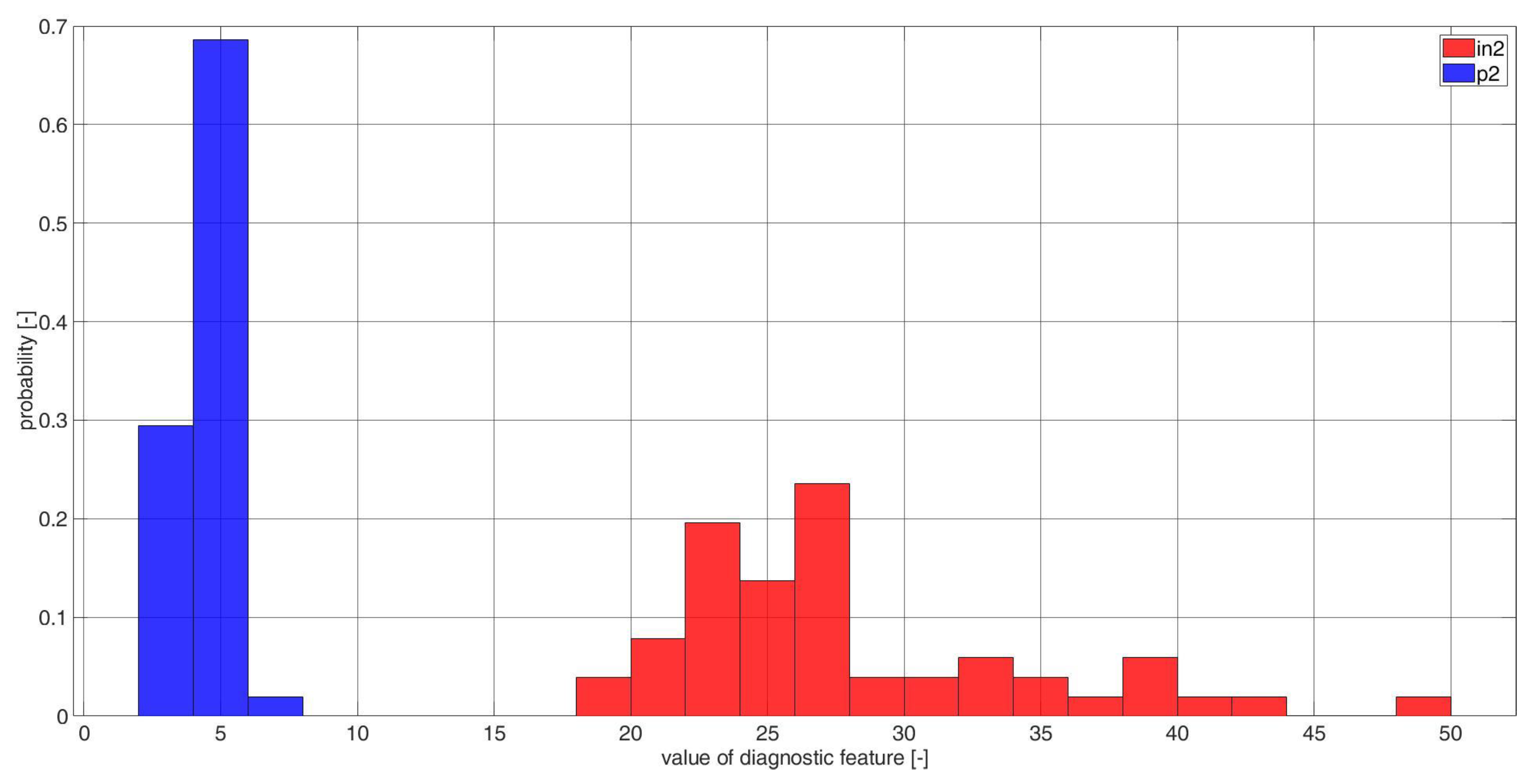


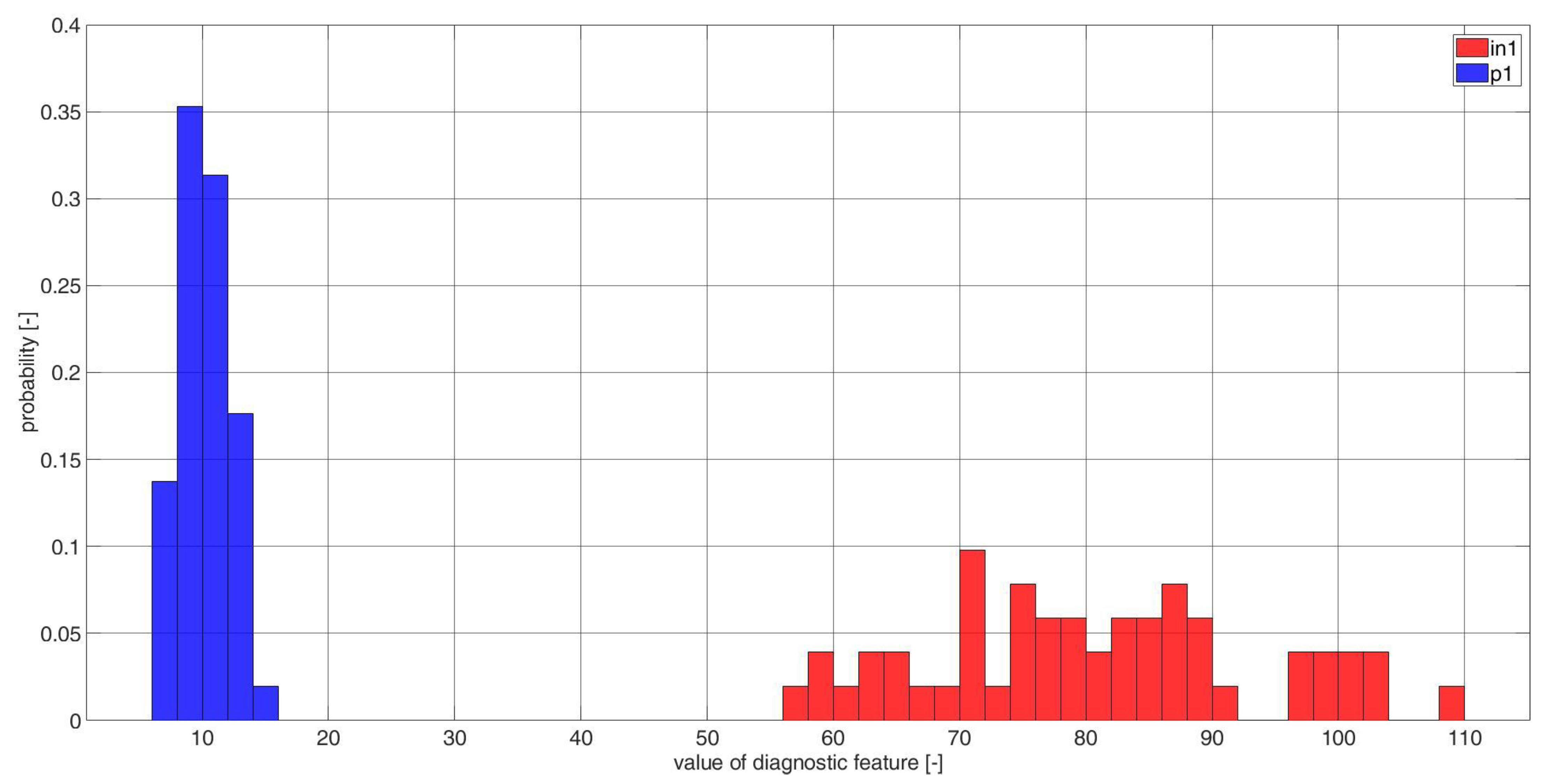


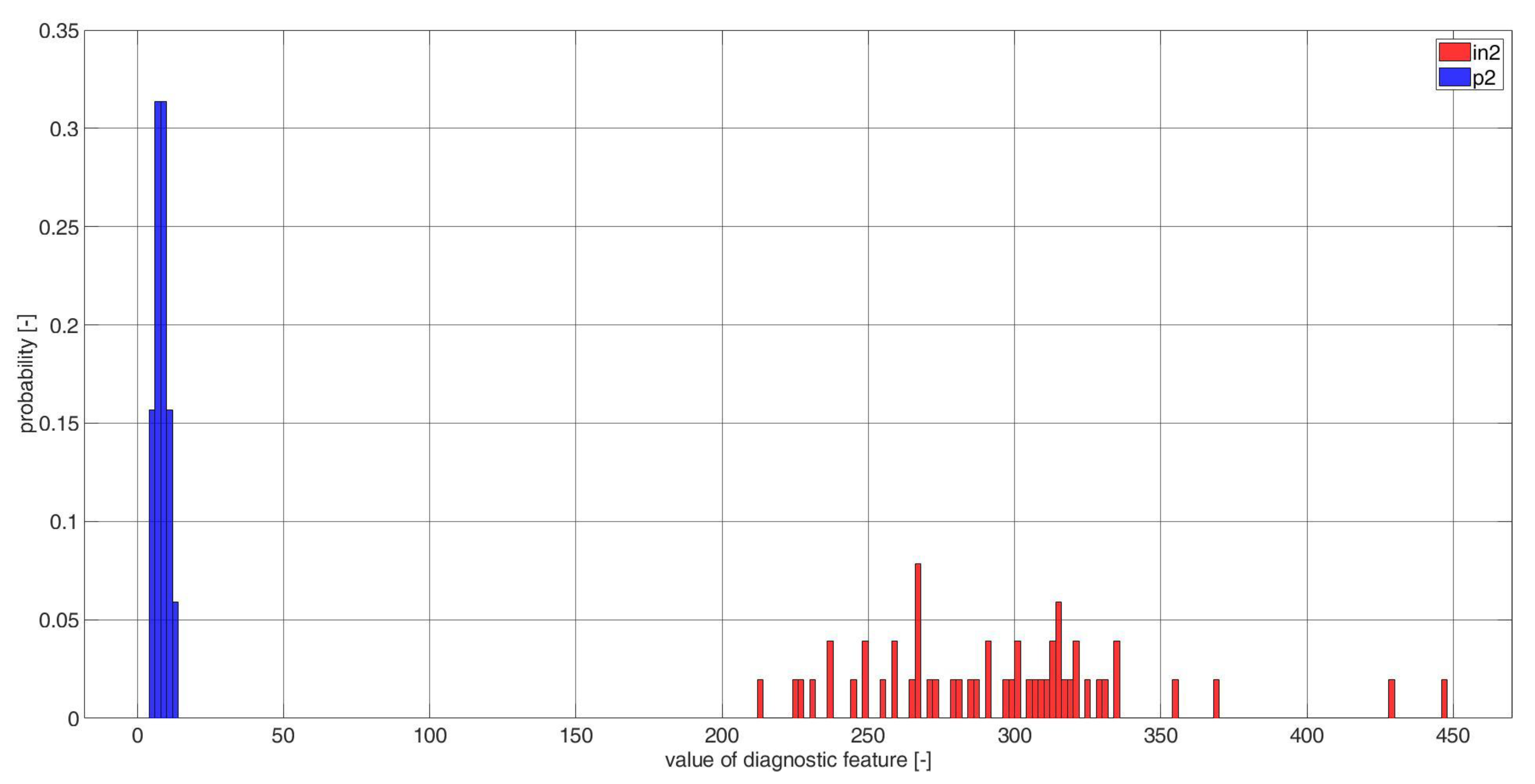
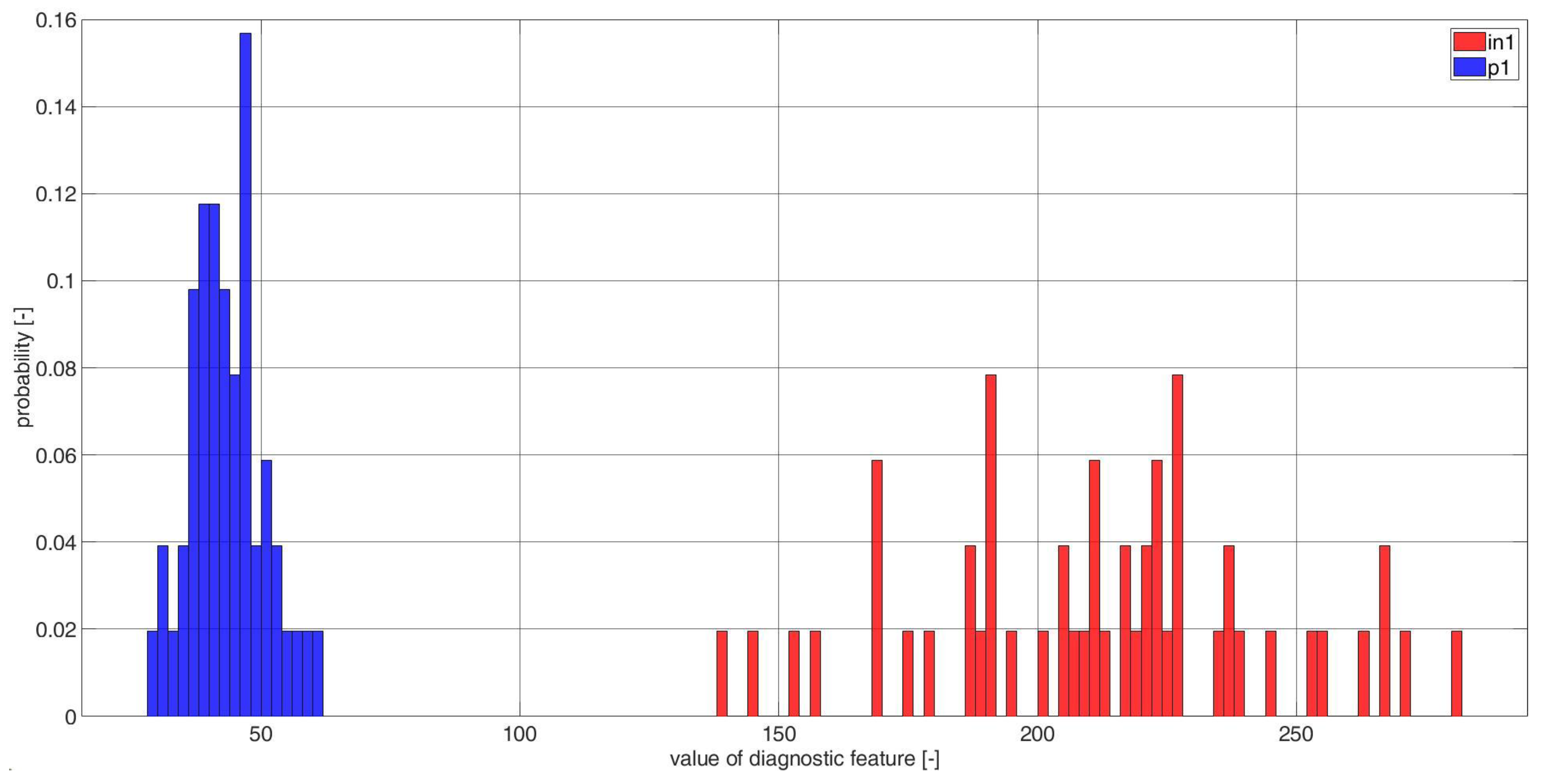
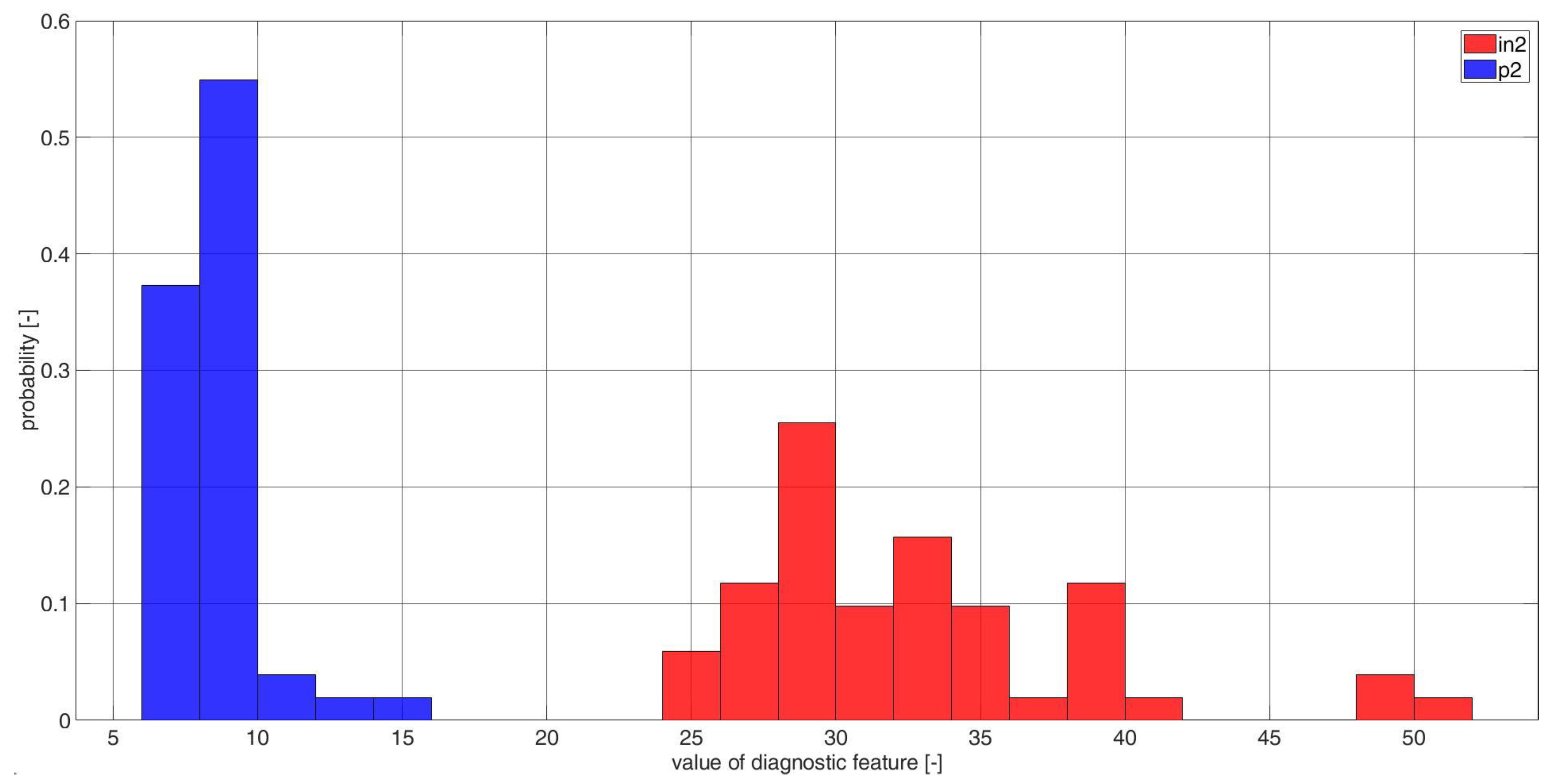
| Correlation Number | i | j |
|---|---|---|
| 1 | 4 | −5 |
| 4 | −3 | |
| 4 | −1 | |
| 2 | 4 | 1 |
| 4 | 3 | |
| 4 | 5 | |
| 3 | 8 | −5 |
| 8 | −3 | |
| 8 | −1 | |
| 4 | 8 | 1 |
| 8 | 3 | |
| 8 | 5 |


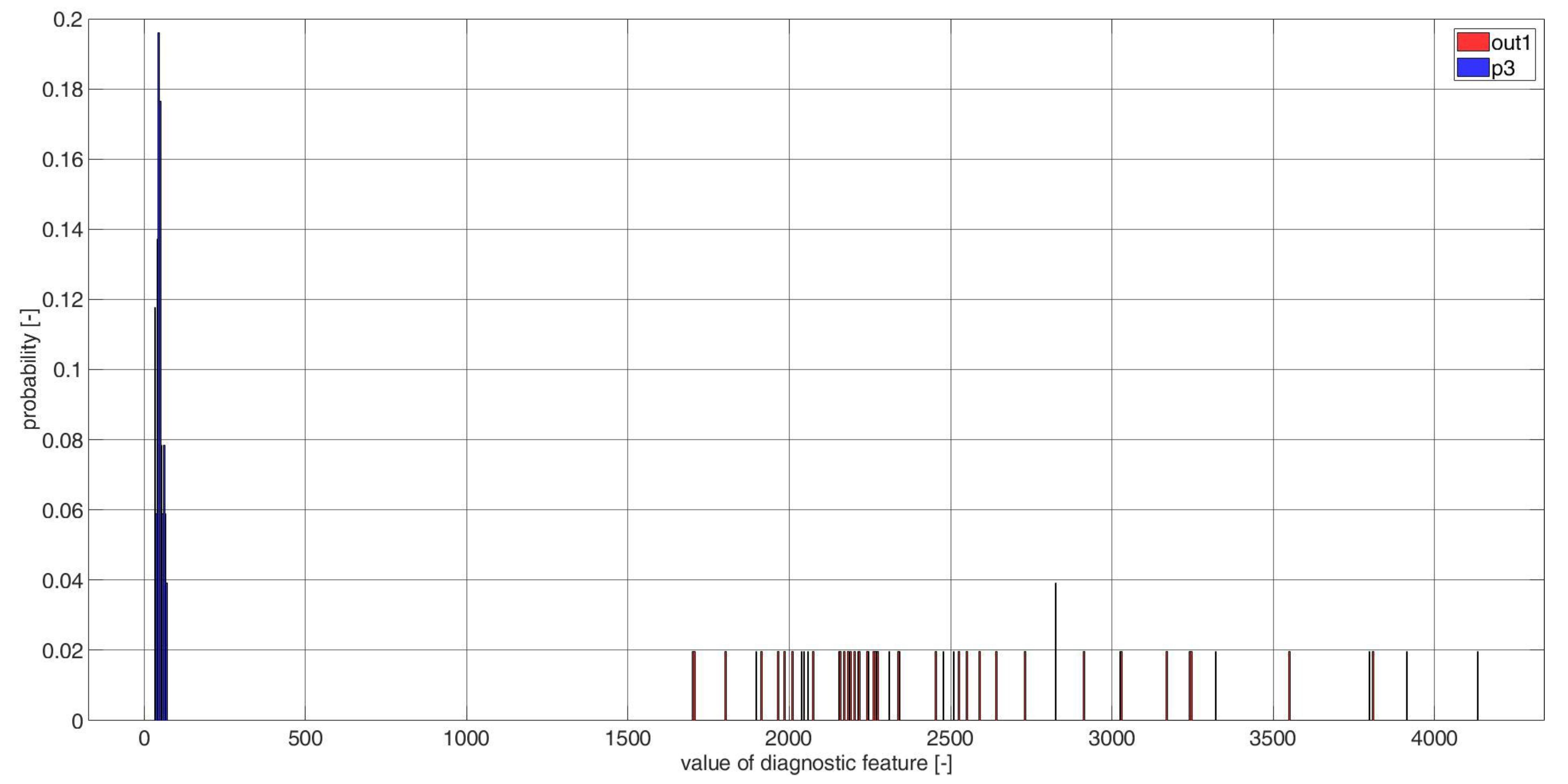

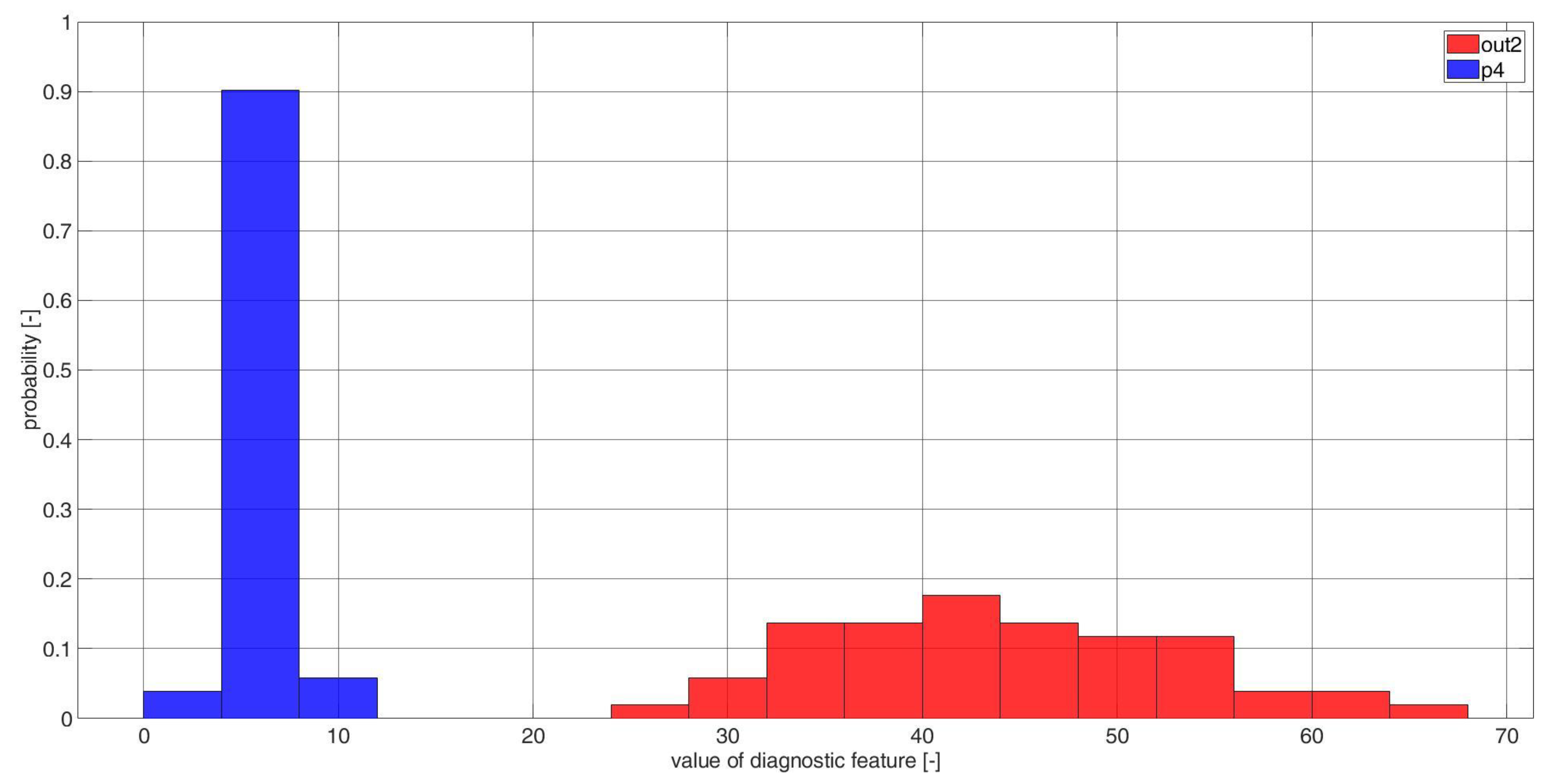
References
- Ciszewski, T.; Gelman, L.; Ball, A. Novel fault identification for electromechanical systems via spectral technique and electrical data processing. Electronics 2020, 9, 1560. [Google Scholar] [CrossRef]
- Gelman, L.; Soliński, K.; Ball, A. Novel higher-order spectral cross-correlation technologies for vibration sensor-based diagnosis of gearboxes. Sensors 2020, 20, 5131. [Google Scholar] [CrossRef]
- Ciszewski, T.; Gelman, L.; Swędrowski, L. Current-based higher-order spectral covariance as a bearing diagnostic feature for induction motors. Insight-Non-Destr. Test. Cond. Monit. 2016, 58, 431–434. [Google Scholar] [CrossRef]
- Schoen, R.; Habetler, T.G.; Kamran, F.; Bartheld, R.G. Motor bearing damage detection, using stator current monitoring. IEEE Trans. Ind. Appl. 1995, 31, 6. [Google Scholar] [CrossRef]
- Areias, I.A.d.S.; Borges da Silva, L.E.; Bonaldi, E.L.; de Lacerda de Oliveira, L.E.; Lambert-Torres, G.; Bernardes, V.A. Evaluation of Current Signature in Bearing Defects by Envelope Analysis of the Vibration in Induction Motors. Energies 2019, 12, 4029. [Google Scholar] [CrossRef] [Green Version]
- Singh, S.; Kumar, N. Detection of Bearing Faults in Mechanical Systems Using Stator Current Monitoring. IEEE Trans. Ind. Inform. 2017, 13, 1341–1349. [Google Scholar] [CrossRef]
- Gangsar, P.; Tiwari, R. Signal based condition monitoring techniques for fault detection and diagnosis of induction motors: A state-of-the-art review. Mech. Syst. Signal Process. 2020, 144, 106908. [Google Scholar] [CrossRef]
- Han, Q.; Ding, Z.; Xu, X.; Wang, T.; Chu, F. Stator current model for detecting rolling bearing faults in induction motors using magnetic equivalent circuits. Mech. Syst. Signal Process. 2019, 131, 554–575. [Google Scholar] [CrossRef]
- Blödt, M.; Granjon, P.; Raison, B.; Rostaing, G. Models for Bearing Damage Detection in Induction Motors Using Stator Current Monitoring. IEEE Trans. Ind. Electron. 2008, 55, 1813–1822. [Google Scholar] [CrossRef] [Green Version]
- Acosta, G.G.; Verucchi, C.J.; Gelso, E.R. A current monitoring system for diagnosing electrical failures in induction motors. Mech. Syst. Signal Proc. 2006, 20, 953–965. [Google Scholar] [CrossRef]
- Gelman, L.; Chandra, N.H.; Kurosz, R.; Pellicano, F.; Barbieri, M.; Zippo, A. Novel spectral kurtosis technology for adaptive vibration condition monitoring of multi-stage gearboxes. Insight-Non-Destr. Test. Cond. Monit. 2016, 58, 409–416. [Google Scholar] [CrossRef]
- Combet, F.; Gelman, L.; Anuzis, P.; Slater, R. Vibration detection of local gear damage by advanced demodulation and residual techniques, Proceedings of the Institution of Mechanical Engineers. Part G J. Aerosp. Eng. 2009, 223, 507–514. [Google Scholar] [CrossRef]
- Gryllias, K.; Gelman, L.; Shaw, B.; Vaidhianathasamy, M. Local damage diagnosis in gearboxes using novel wavelet technology. Int. J. Insight-Non-Destr. Test. Cond. Monit. 2010, 52, 437–442. [Google Scholar] [CrossRef]
- Gelman, L.; Kripak, D.A.; Fedorov, V.V.; Udovenko, L.N. Condition monitoring diagnosis methods of helicopter units. Mech. Syst. Signal Process. 2000, 14, 613–624. [Google Scholar] [CrossRef]
- Kolbe, S.; Gelman, L.; Ball, A. Novel prediction of diagnosis effectiveness for adaptation of the spectral kurtosis technology to varying operating conditions. Sensors 2021, 21, 6913. [Google Scholar] [CrossRef] [PubMed]
- Gelman, L.; Soliński, K.; Ball, A. Novel instantaneous wavelet bicoherence for vibration fault detection in gear systems. Energies 2021, 14, 6811. [Google Scholar] [CrossRef]
- Gelman, L.; Kolbe, S.; Shaw, B.; Vaidhianathasamy, M. Novel adaptation of the spectral kurtosis for vibration diagnosis of gearboxes in non-stationary conditions. Int. J. Insight-Non-Destr. Test. Cond. Monit. 2017, 59, 434–439. [Google Scholar] [CrossRef]
- Gelman, L.; Solinski, K.; Shaw, B.; Vaidhianathasamy, M. Vibration diagnosis of a gearbox by wavelet bicoherence technology. Int. J. Insight-Non-Destr. Test. Cond. Monit. 2017, 59, 440–444. [Google Scholar] [CrossRef] [Green Version]
- Corne, B.; Vervisch, B.; Derammelaere, S.; Knockaert, J.; Desmet, J. The reflection of evolving bearing faults in the stator current’s extended park vector approach for induction machines. Mech. Syst. Signal Process. 2018, 107, 168–182. [Google Scholar] [CrossRef]
- Silva, J.L.H.; Cardoso, A.J.M. Bearing failures diagnosis in three-phase induction motors by extended Park’s vector approach. In Proceedings of the 31st Annual Conference of IEEE Industrial Electronics Society, 2005. IECON 2005, Raleigh, NC, USA, 6–10 November 2005. [Google Scholar]
- Wang, C.; Wang, M.; Yang, B.; Song, K.; Zhang, Y.; Liu, L. A novel methodology for fault size estimation of ball bearings using stator current signal. Measurement 2021, 171, 108723. [Google Scholar] [CrossRef]
- Treetrong, J. Fault Detection and Diagnosis of Induction Motors Based on Higher-Order Spectrum. In Proceedings of the International Multi Conference of Engineers and Computer Scientists, Honk Kong, China, 17–19 May 2010; Volume II. [Google Scholar]
- Song, X.; Hu, J.; Zhu, H.; Zhang, J. A Bearing Outer Raceway Fault Detection Method in Induction Motors Based on Instantaneous Frequency of the Stator Current. IEEJ Trans. Electr. Electron. Eng. 2018, 13, 510–516. [Google Scholar] [CrossRef]
- Tulicki, J.; Sułowicz, M.; Pragłowska-Ryłko, N. Application of the Bispectral Analysis in the Diagnosis of Cage Induction Motors. In Proceedings of the 2016 13th Selected Issues of Electrical Engineering and Electronics (WZEE), Rzeszow, Poland, 4–8 May 2016. [Google Scholar] [CrossRef]
- Zhao, D.; Gelman, L.; Chu, F.; Ball, A. Vibration health monitoring of rolling bearings under variable speed conditions by novel demodulation technique. Struct. Control. Health Monit. 2020, 28, e2672. [Google Scholar] [CrossRef]
- Gelman, L.; Patel, T.H.; Persin, G.; Murray, B.; Thomson, A. Novel technology based on the spectral kurtosis and wavelet transform for rolling bearing diagnosis. Int. J. Progn. Health Manag. 2013, 4, 2153–2648. [Google Scholar] [CrossRef]
- Gelman, L.; Murray, B.; Patel, T.H.; Thomson, A. Vibration diagnostics of rolling bearings by novel nonlinear non-stationary wavelet bicoherence technology. Eng. Struct. 2014, 80, 514–520. [Google Scholar] [CrossRef]
- Gelman, L.; Persin, G. Novel fault diagnosis of bearings and gearboxes based on simultaneous processing of spectral kurtoses. Appl. Sci. 2022, 12, 9970. [Google Scholar] [CrossRef]
- Zarei, J.; Poshtan, J. An Advanced Park’s Vectors Approach for Bearing Fault Detection. IEEE Int. Conf. Ind. Technol. 2006, 42, 213–219. [Google Scholar] [CrossRef]
- Gao, Z.; Turner, L.; Colby, R.S.; Leprettre, B. Frequency Demodulation Approach to Induction Motor Speed Detection. IEEE Trans. Ind. Appl. 2011, 47, 730–738. [Google Scholar] [CrossRef]
- Eren, L.; Karahoca, A.; Devaney, M.J. Neural network based motor bearing fault detection. In Proceedings of the 21st IEEE Instrumentation and Measurement Technology Conference, Como, Italy, 18–20 May 2004; Volume 3, pp. 1657–1660. [Google Scholar] [CrossRef]
- Eren, L.; Teotrakool, K.; Devaney, M.J. Bearing fault detection via wavelet packet decomposition with spectral post processing. In Proceedings of the 2007 IEEE Instrumentation & Measurement Technology Conference IMTC 2007, Warsaw, Poland, 1–3 May 2007; pp. 1–4. [Google Scholar] [CrossRef]
- Nikolaou, N.G.; Antoniadis, I.A. Rolling element bearing fault diagnosis using wavelet packets. NDT E Int. 2002, 35, 197–205. [Google Scholar] [CrossRef]
- Lou, X.; Loparo, K. Bearing fault diagnosis based on wavelet transform and fuzzy inference. Mech. Syst. Signal Process. 2004, 18, 1077–1095. [Google Scholar] [CrossRef]
- Yaqub, M.F.; Loparo, K.A. An automated approach for bearing damage detection. J. Vib. Control. 2016, 22, 3253–3266. [Google Scholar] [CrossRef]
- Yiakopoulos, C.; Antoniadis, I. Wavelet Based Demodulation of Vibration Signals Generated by Defects in Rolling Element Bearings. In Proceedings of the ASME 2001 International Design Engineering Technical Conferences and Computers and Information in Engineering Conference, Volume 6C: 18th Biennial Conference on Mechanical Vibration and Noise. Pittsburgh, PA, USA, 9–12 September 2001; pp. 3187–3195. [Google Scholar] [CrossRef]
- Dahiya, N.M.R. Detection of Bearing Faults of Induction Motor Using Park’s Vector Approach. Int. J. Eng. 2010, 1, 263–266. [Google Scholar]
- Saeidi, M.; Zarei, J.; Hassani, H.; Zamani, A.; Majid, S. Bearing fault detection via Park’s vector approach based on ANFIS. In Proceedings of the 2014 International Conference on Mechatronics and Control (ICMC), Jinzhou, China, 3–5 July 2014. [Google Scholar] [CrossRef]
- Irfan, M.; Saad, N.; Ibrahim, R.; Asirvadam, V.S.; Alwadie, A. Analysis of distributed faults in inner and outer race of bearing via Park vector analysis method. Neural Comput. Appl. 2019, 31, 683–691. [Google Scholar] [CrossRef]
- Koteleva, N.; Korolev, N.; Zhukovskiy, Y.; Baranov, G. A Soft Sensor for Measuring the Wear of an Induction Motor Bearing by the Park’s Vector Components of Current and Voltage. Sensors 2021, 21, 7900. [Google Scholar] [CrossRef] [PubMed]
- Zarei, J.; Poshtan, J. An advanced Park’s vectors approach for bearing fault detection. Tribol. Int. 2009, 42, 213–219. [Google Scholar] [CrossRef]
- Gyftakis, K.N.; Marques Cardoso, A.J.; Antonino-Daviu, J.A. Introducing the Filtered Park’s and Filtered Extended Park’s Vector Approach to detect broken rotor bars in induction motors independently from the rotor slots number. Mech. Syst. Signal Process. 2017, 93, 30–50. [Google Scholar] [CrossRef]
- Messaoudi, M.; Flah, A.; Alotaibi, A.A.; Althobaiti, A.; Sbita, L.; Ziad El-Bayeh, C. Diagnosis and Fault Detection of Rotor Bars in Squirrel Cage Induction Motors Using Combined Park’s Vector and Extended Park’s Vector Approaches. Electronics 2022, 11, 380. [Google Scholar] [CrossRef]
- Bouslimani, S.; Drid, S.; Chrifi-Alaoui, L.; Bussy, P.; Ouriagli, M.; Delahoche, L. An extended Park’s vector approach to detect broken bars faults in induction motor. In Proceedings of the 15th International Conference on Sciences and Techniques of Automatic Control and Computer Engineering (STA), Hammamet, Tunisia, 21–23 December 2014. [Google Scholar]
- Zhang, Q.X.; Li, J.; Bin Li, H.; Liu, C. Motor Broken-Bar Fault Diagnosis Based on Park Vector and Wavelet Neural Network. In Advanced Materials Research; Trans Tech Publications, Ltd.: Stafa-Zurich, Switzerland, 2011; Volume 382, pp. 163–166. [Google Scholar]
- Zarei, J.; Hassani, H.; Wei, Z.; Karimi, H.R. Broken rotor bars detection via Park’s vector approach based on ANFIS. In Proceedings of the IEEE 23rd International Symposium on Industrial Electronics (ISIE), Istanbul, Turkey, 1–4 June 2014. [Google Scholar]
- Guo, Q.; Li, X.; Yu, H.; Hu, W.; Hu, J. Broken Rotor Bars Fault Detection in Induction Motors Using Park’s Vector Modulus and FWNN Approach. In International Symposium on Neural Networks; Springer: Berlin/Heidelberg, Germany, 2008; Advances in Neural Networks—ISNN; pp. 809–821. [Google Scholar]
- Estima, J.O.; Freire, N.M.; Cardoso, A.M. Recent advances in fault diagnosis by Park’s vector approach. In Proceedings of the 2013 IEEE Workshop on Electrical Machines Design, Control and Diagnosis (WEMDCD), Paris, France, 11–12 March 2013. [Google Scholar]
- Cruz, S.M.; Cardoso, A.M. Stator winding fault diagnosis in three-phase synchronous and asynchronous motors, by the extended Park’s vector approach. IEEE Trans. Ind. Appl. 2001, 37, 1227–1233. [Google Scholar] [CrossRef]
- Nejjari, H.; Benbouzid, M.E.H. Monitoring and diagnosis of induction motors electrical faults using a current Park’s vector pattern learning approach. IEEE Trans. Ind. Appl. 2000, 36, 3. [Google Scholar] [CrossRef]
- Wei, S.; Zhang, X.; Xu, Y.; Fu, Y.; Ren, Z.; Li, F. Extended Park’s vector method in early inter-turn short circuit fault detection for the stator windings of offshore wind doubly-fed induction generators. IET Gener. Transm. Distrib. 2020, 14, 3905–3912. [Google Scholar] [CrossRef]
- Sharma, A.; Chatterji, S.; Mathew, L. A novel Park’s vector approach for investigation of incipient stator fault using MCSA in three-phase induction motors. In Proceedings of the International Conference on Innovations in Control, Communication and Information Systems (ICICCI), Greater Noida, India, 12–13 August 2017. [Google Scholar]
- Beesack, P. Inequalities for Absolute Moments of a Distribution: From Laplace to Von Mises. J. Math. Anal. Appl. 1984, 98, 435–457. [Google Scholar] [CrossRef] [Green Version]
- Winkelbauer, A. Moments and Absolute Moments of the Normal Distribution. arXiv 2014, arXiv:1209.4340. [Google Scholar]
- Eriksson, J.; Ollila, E.; Koivunen, V. Statistics for complex random variables revisited. In Proceedings of the 34th IEEE International Conference on Acoustics, Speech, and Signal Processing, Taipei, Taiwan, 19–24 April 2009; pp. 3565–3568. [Google Scholar] [CrossRef]
- Eriksson, J.; Ollila, E.; Koivunen, V. Essential Statistics and Tools for Complex Random Variables. IEEE Trans. Signal Process. 2010, 58, 5400–5408. [Google Scholar] [CrossRef]
- Ollila, E. On the Circularity of a Complex Random Variable. IEEE Signal Process. Lett. 2008, 15, 841–844. [Google Scholar] [CrossRef]
- Nikias, C.L.; Mendel, J.M. Signal processing with higher-order spectra. IEEE Signal Process. Mag. 1993, 10, 10–37. [Google Scholar] [CrossRef]
- Memon, Q. Higher-order spectra computation using wavelet transform. In Proceedings of the SPIE—The International Society for Optical Engineering, Orlando, FL, USA, 7 July 2000. [Google Scholar] [CrossRef]
- Gelman, L.; Braun, S. The optimal usage of the Fourier transform for pattern recognition. Mech. Syst. Signal Process. 2001, 15, 641–645. [Google Scholar] [CrossRef]
- Budny, K. Estimation of the Central Moments of a Random Vector Based on the Definition of the Power of a Vector, Statistics in Transition New Series; Exeley: New York, NY, USA, 2017; Volume 18, pp. 1–20. [Google Scholar]
- Gelman, L.; Ottley, M. New processing techniques for transient signals with nonlinear variation of the instantaneous frequency in time. Mech. Syst. Signal Process. 2006, 20, 1254–1262. [Google Scholar] [CrossRef]
- Gelman, L.; Gould, J.D. Time-frequency chirp-Wigner transform for signals with any nonlinear polynomial time varying instantaneous frequency. Mech. Syst. Signal Process. 2007, 21, 2980–3002. [Google Scholar] [CrossRef]
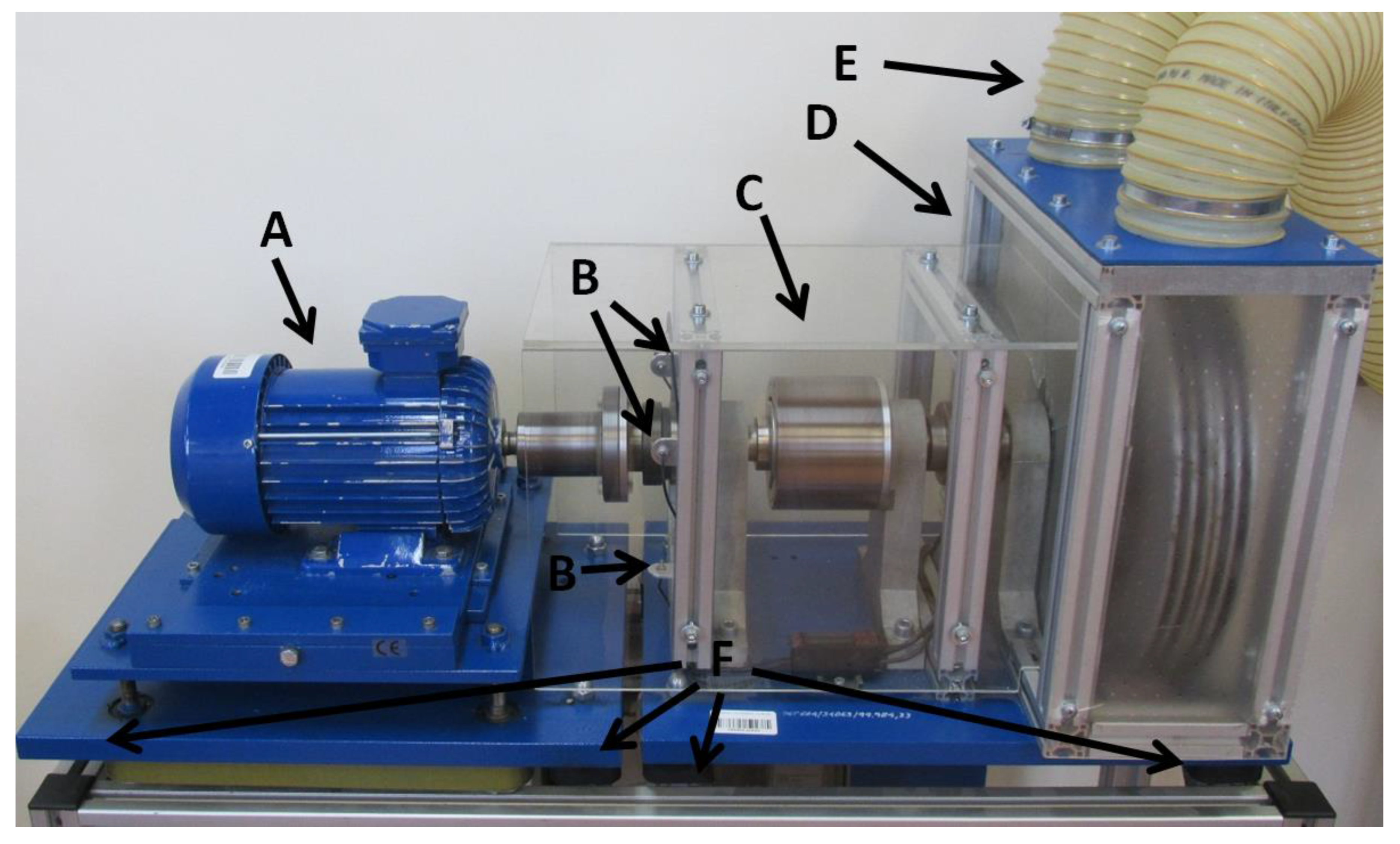
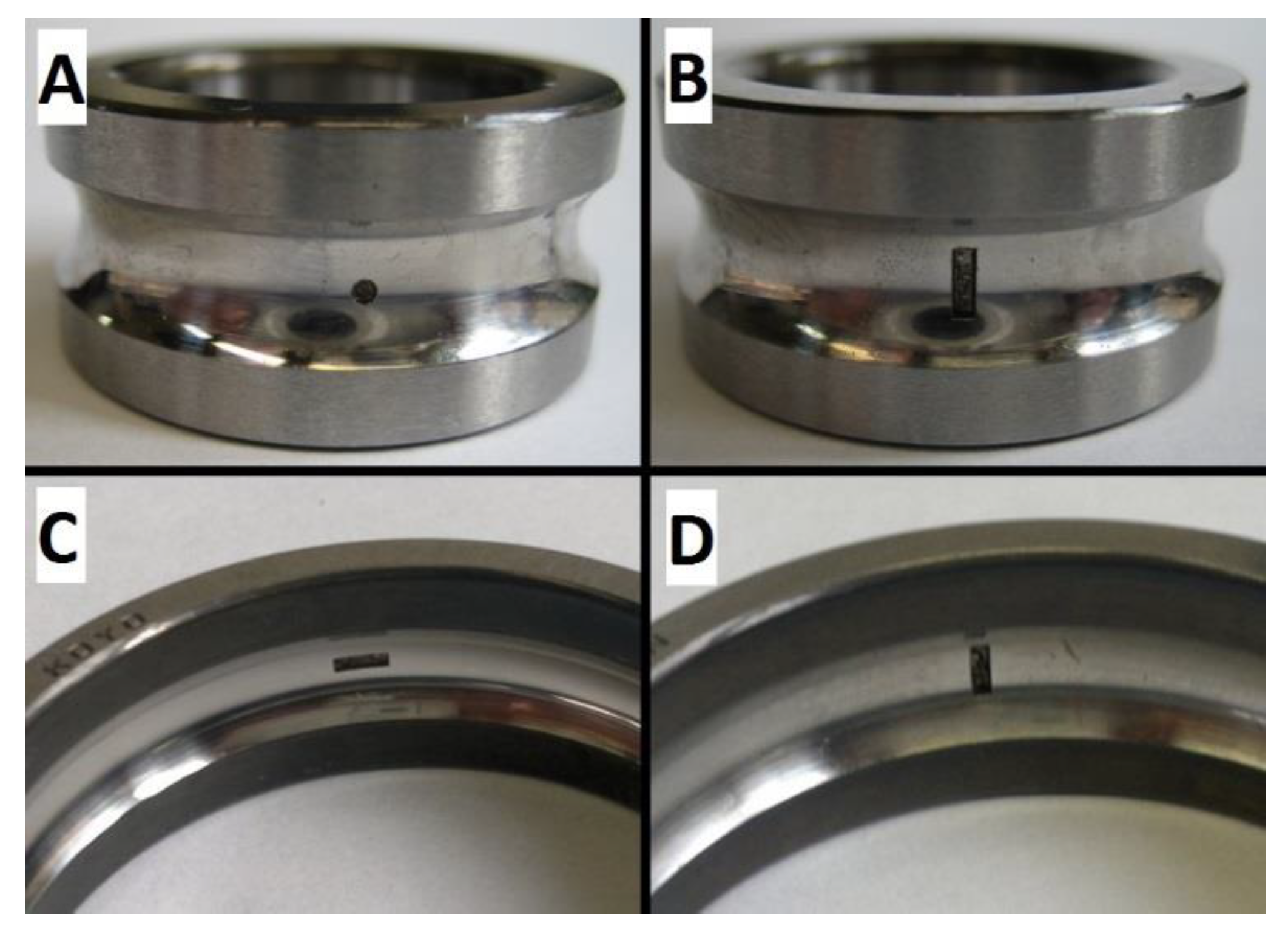



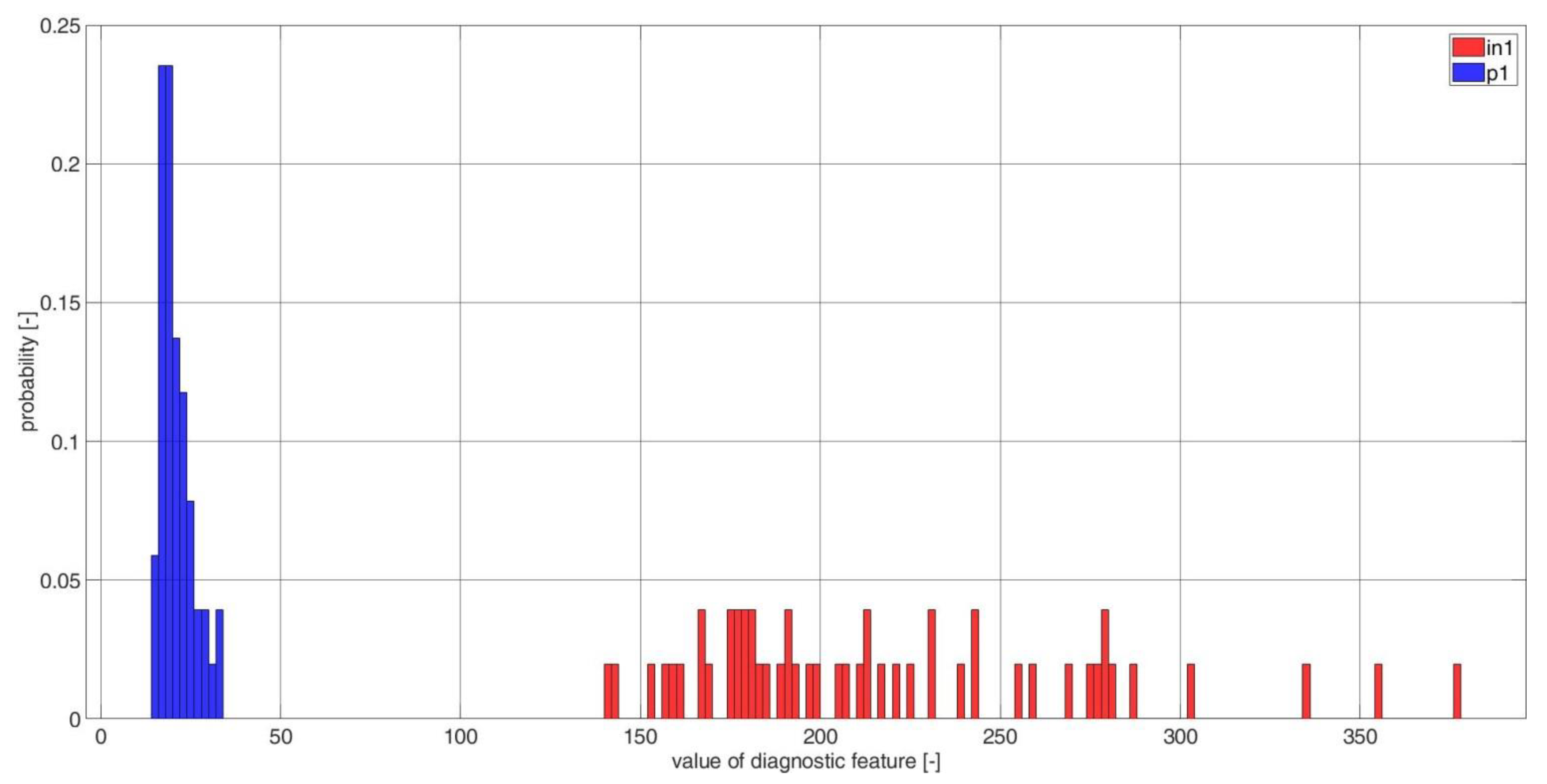

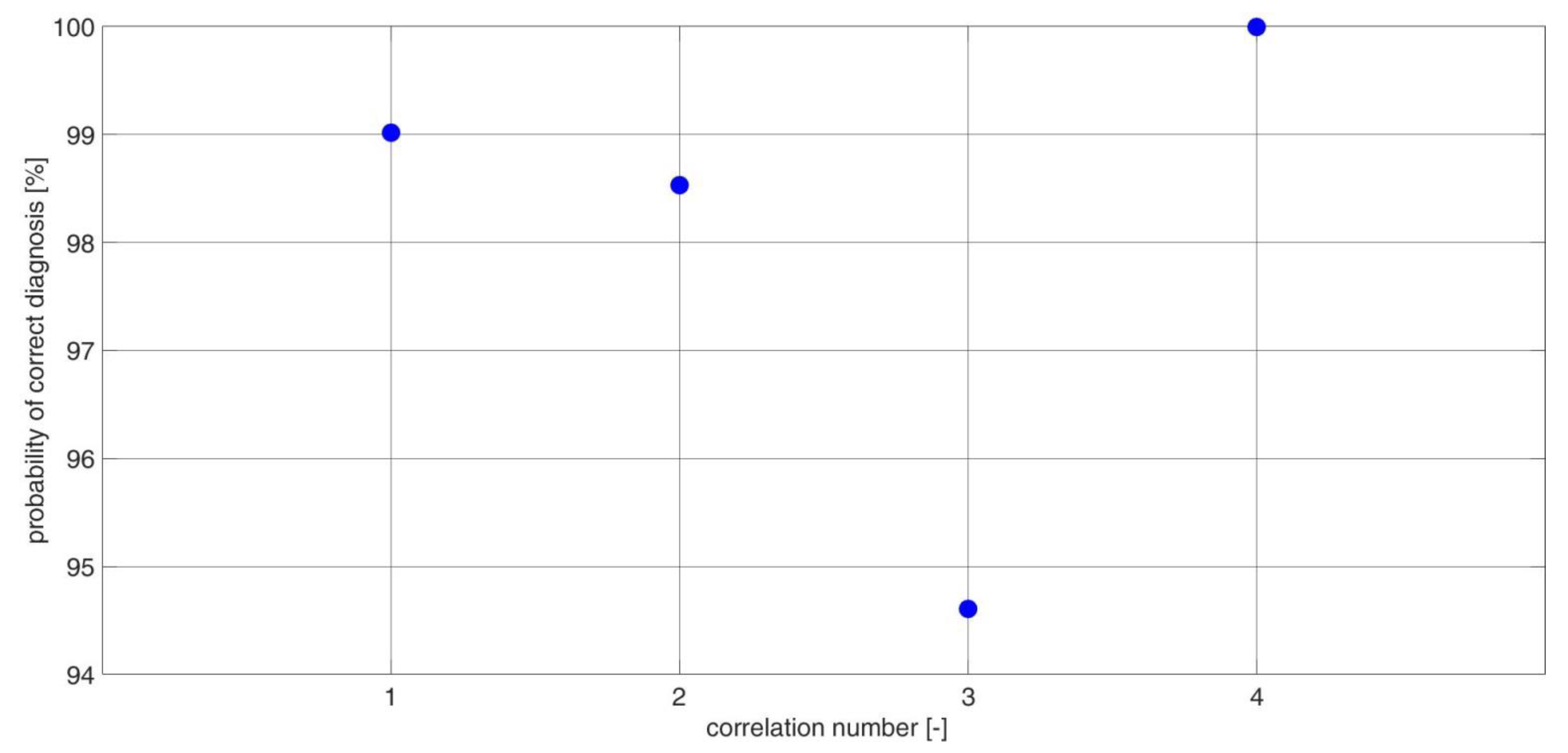
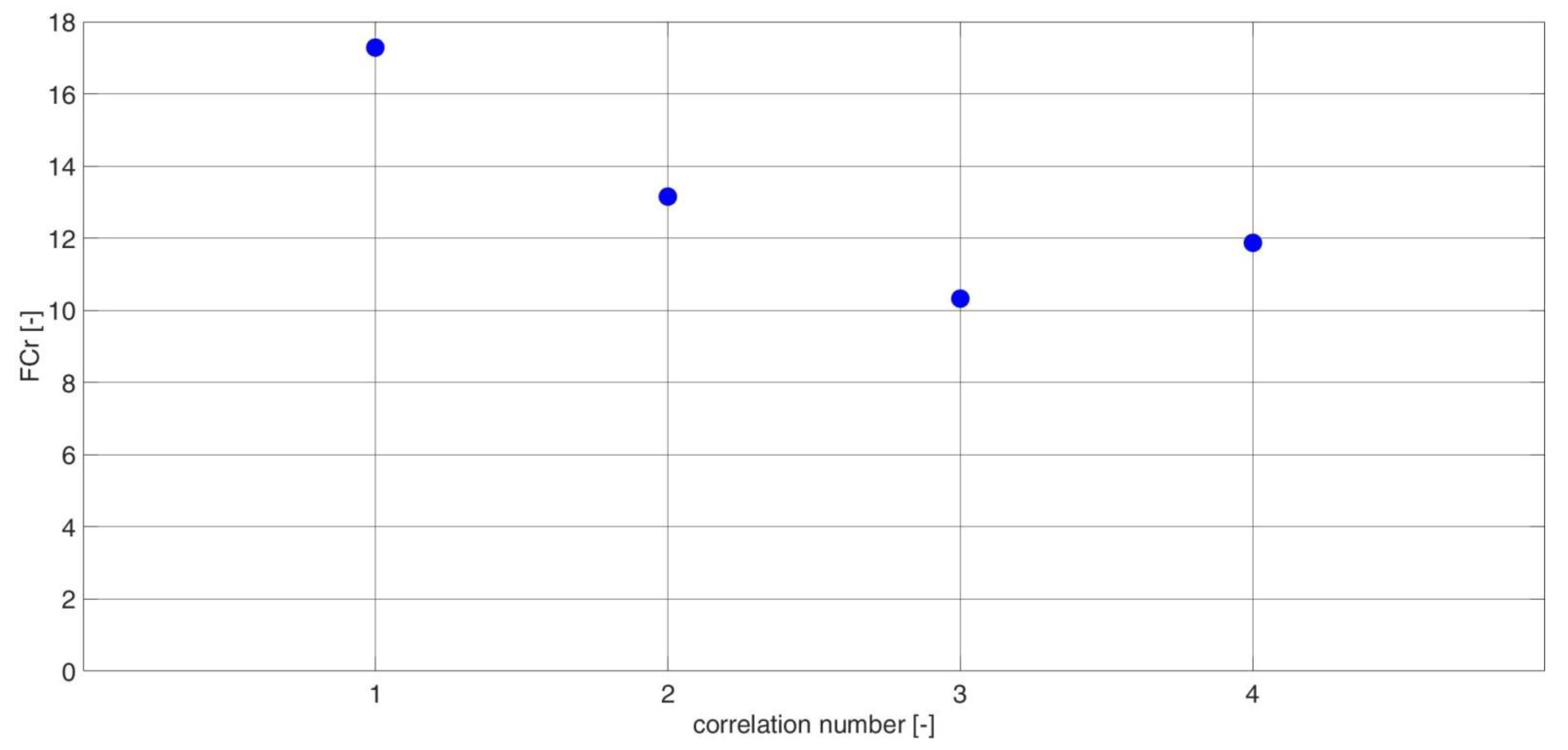

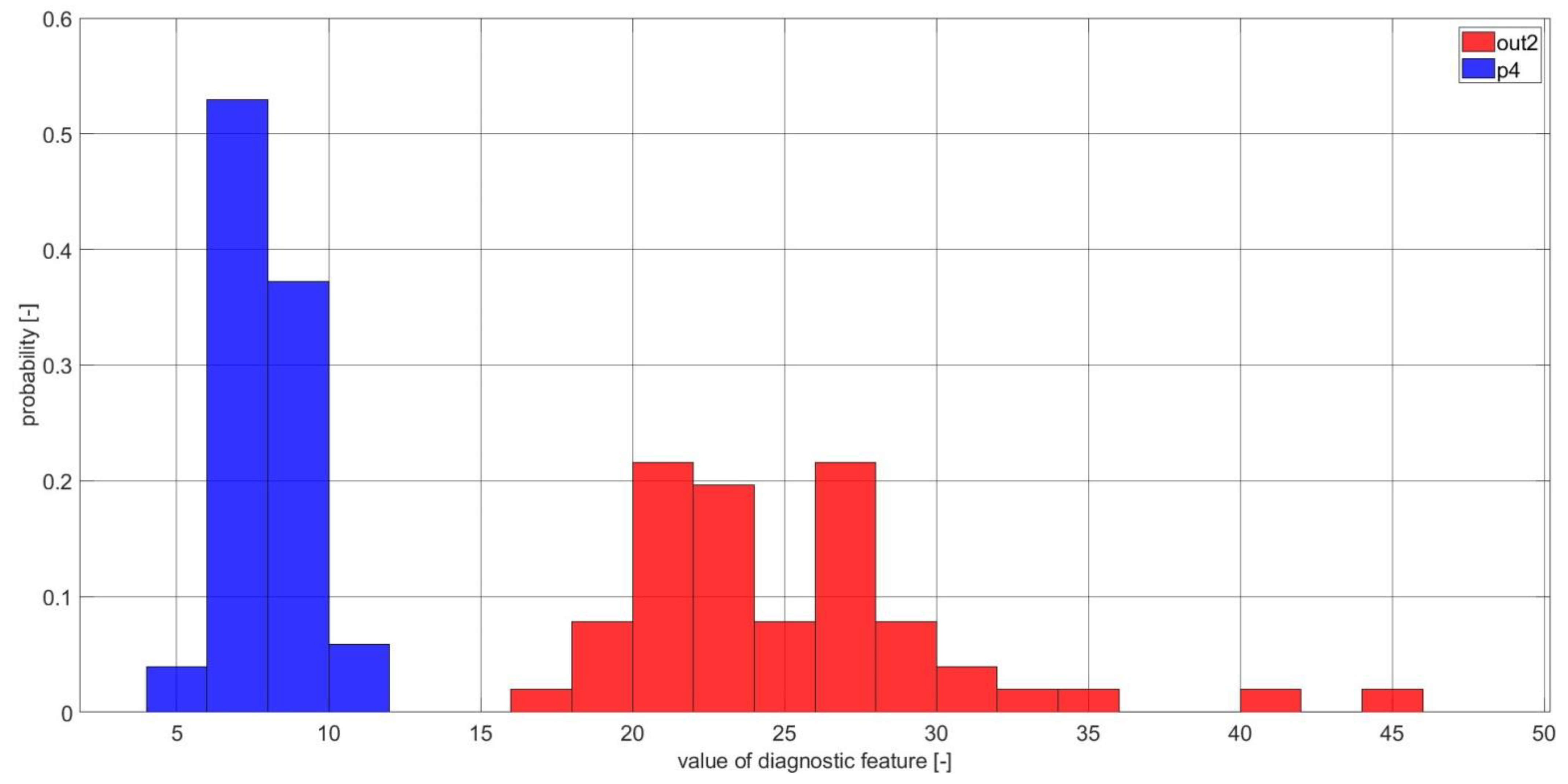
| Bearing | Introduced Damage | Relative Damage Size | Figure |
|---|---|---|---|
| in1 | inner race pit damage with 1 mm diameter and depth of 0.5 mm | 1.20% | Figure 2A |
| in2 | inner race scratch damage length of 3 mm, width of 1 mm and depth of 0.7 mm | 1.20% | Figure 2B |
| out1 | outer race scratch damage along the bearing rolling direction with length of 3 mm, width of 1 mm and depth of 0.5 mm | 2.23% | Figure 2C |
| out2 | outer race scratch damage length of 3 mm, width of 1 mm and depth of 0.5 mm | 0.78% | Figure 2D |
Publisher’s Note: MDPI stays neutral with regard to jurisdictional claims in published maps and institutional affiliations. |
© 2022 by the authors. Licensee MDPI, Basel, Switzerland. This article is an open access article distributed under the terms and conditions of the Creative Commons Attribution (CC BY) license (https://creativecommons.org/licenses/by/4.0/).
Share and Cite
Ciszewski, T.; Gelman, L.; Ball, A. Novel Nonlinear High Order Technologies for Damage Diagnosis of Complex Assets. Electronics 2022, 11, 3885. https://doi.org/10.3390/electronics11233885
Ciszewski T, Gelman L, Ball A. Novel Nonlinear High Order Technologies for Damage Diagnosis of Complex Assets. Electronics. 2022; 11(23):3885. https://doi.org/10.3390/electronics11233885
Chicago/Turabian StyleCiszewski, Tomasz, Len Gelman, and Andrew Ball. 2022. "Novel Nonlinear High Order Technologies for Damage Diagnosis of Complex Assets" Electronics 11, no. 23: 3885. https://doi.org/10.3390/electronics11233885







